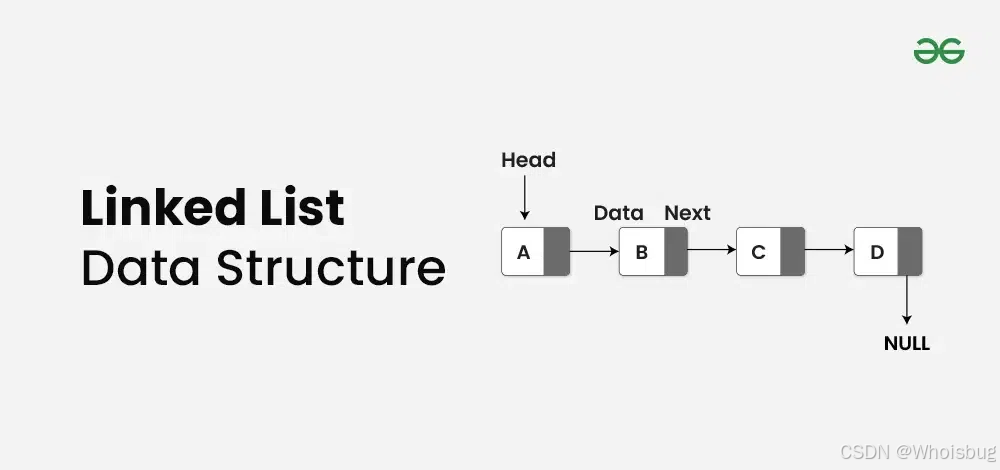链表是一种常见的数据结构,它由一系列节点组成,每个节点包含数据部分和指向下一个节点的指针。链表具有动态大小和高效插入、删除操作的特点,使其在许多应用场景中都非常有用。本文将详细介绍链表的基本概念、操作以及应用场景,并通过示例和图表来帮助你更好地理解链表。

链表的基本概念
链表是一种线性数据结构,其中的元素以节点的形式存储,每个节点包含两部分:数据和指向下一个节点的指针。链表的最后一个节点的指针指向null,表示链表的结束。
单链表(Singly Linked List)
单链表是最简单的链表形式,每个节点只有一个指向下一个节点的指针。单链表的节点结构如下:
class ListNode:
def __init__(self, value=0, next=None):
self.value = value
self.next = next
双链表(Doubly Linked List)
双链表的每个节点有两个指针,一个指向前一个节点,另一个指向后一个节点。双链表的节点结构如下:
class ListNode:
def __init__(self, value=0, prev=None, next=None):
self.value = value
self.prev = prev
self.next = next
循环链表(Circular Linked List)
循环链表的最后一个节点的指针指向第一个节点,形成一个闭环。循环链表可以是单向的,也可以是双向的。
链表的操作
链表的基本操作包括插入、删除、查找和遍历。这些操作的时间复杂度通常为O(n),因为可能需要遍历整个链表。
插入操作
在链表中插入节点可以在头部、尾部或中间位置进行。插入操作的时间复杂度为O(1),但找到插入位置的时间复杂度为O(n)。
在头部插入
def insert_at_head(head, value):
new_node = ListNode(value)
new_node.next = head
return new_node
在尾部插入
def insert_at_tail(head, value):
new_node = ListNode(value)
if head is None:
return new_node
current = head
while current.next:
current = current.next
current.next = new_node
return head
在中间插入
def insert_at_middle(head, value, position):
if position == 0:
return insert_at_head(head, value)
new_node = ListNode(value)
current = head
for _ in range(position - 1):
if current is None:
return head
current = current.next
new_node.next = current.next
current.next = new_node
return head
删除操作
在链表中删除节点可以在头部、尾部或中间位置进行。删除操作的时间复杂度为O(1),但找到删除位置的时间复杂度为O(n)。
删除头部节点
def delete_at_head(head):
if head is None:
return None
return head.next
删除尾部节点
def delete_at_tail(head):
if head is None:
return None
if head.next is None:
return None
current = head
while current.next.next:
current = current.next
current.next = None
return head
删除中间节点
def delete_at_middle(head, position):
if head is None or position == 0:
return delete_at_head(head)
current = head
for _ in range(position - 1):
if current is None or current.next is None:
return head
current = current.next
if current.next is None:
return head
current.next = current.next.next
return head
查找操作
在链表中查找节点需要遍历整个链表,时间复杂度为O(n)。
def find_node(head, value):
current = head
while current:
if current.value == value:
return current
current = current.next
return None
遍历操作
遍历链表可以打印出所有节点的值,时间复杂度为O(n)。
def traverse_list(head):
current = head
while current:
print(current.value, end=" -> ")
current = current.next
print("None")
链表的应用场景
链表在许多应用场景中都非常有用,例如:
-
实现栈和队列:链表可以高效地实现栈和队列的插入和删除操作。
-
动态内存分配:链表可以动态地分配内存,适合不确定大小的数据集合。
-
符号表:在编译器中,链表可以用于实现符号表,存储变量和函数的定义。
-
多级反馈队列调度:在操作系统中,链表可以用于实现多级反馈队列调度算法。
示例:实现栈
使用链表实现栈,支持push和pop操作。
class Stack:
def __init__(self):
self.head = None
def push(self, value):
new_node = ListNode(value)
new_node.next = self.head
self.head = new_node
def pop(self):
if self.head is None:
return None
value = self.head.value
self.head = self.head.next
return value
def is_empty(self):
return self.head is None
def top(self):
if self.head is None:
return None
return self.head.value
示例:实现队列
使用链表实现队列,支持enqueue和dequeue操作。
class Queue:
def __init__(self):
self.head = None
self.tail = None
def enqueue(self, value):
new_node = ListNode(value)
if self.tail is None:
self.head = self.tail = new_node
else:
self.tail.next = new_node
self.tail = new_node
def dequeue(self):
if self.head is None:
return None
value = self.head.value
self.head = self.head.next
if self.head is None:
self.tail = None
return value
def is_empty(self):
return self.head is None
def front(self):
if self.head is None:
return None
return self.head.value
链表的变体
双向链表
双向链表的每个节点有两个指针,一个指向前一个节点,另一个指向后一个节点。这使得在双向链表中可以向前和向后遍历。
双向链表的插入操作
def insert_at_head_doubly(head, value):
new_node = ListNode(value)
if head is None:
return new_node
new_node.next = head
head.prev = new_node
return new_node
双向链表的删除操作
def delete_at_head_doubly(head):
if head is None:
return None
if head.next is None:
return None
head = head.next
head.prev = None
return head
循环链表
循环链表的最后一个节点的指针指向第一个节点,形成一个闭环。这使得在循环链表中可以无缝地遍历整个链表。
循环链表的插入操作
def insert_at_tail_circular(head, value):
new_node = ListNode(value)
if head is None:
new_node.next = new_node
return new_node
current = head
while current.next != head:
current = current.next
current.next = new_node
new_node.next = head
return head
循环链表的删除操作
def delete_at_tail_circular(head):
if head is None:
return None
if head.next == head:
return None
current = head
while current.next.next != head:
current = current.next
current.next = head
return head
总结
链表是一种灵活的数据结构,适用于需要动态大小和高效插入、删除操作的场景。通过理解链表的基本概念和操作,你可以更好地应用链表来解决实际问题。希望本文的示例和图表能帮助你更好地理解和掌握链表。





















 1723
1723

 被折叠的 条评论
为什么被折叠?
被折叠的 条评论
为什么被折叠?








